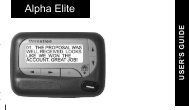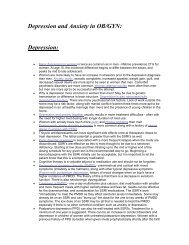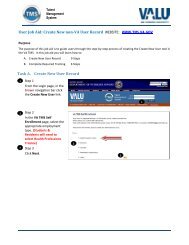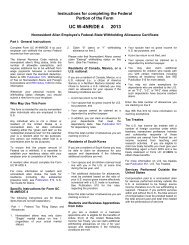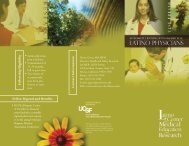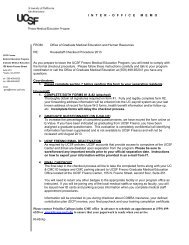Infection Control PPt - UCSF Fresno
Infection Control PPt - UCSF Fresno
Infection Control PPt - UCSF Fresno
Create successful ePaper yourself
Turn your PDF publications into a flip-book with our unique Google optimized e-Paper software.
What You Need to Know<br />
1
• Bacteria and viruses are most commonly<br />
transmitted on the hands of health care workers<br />
2
• The single most important way to prevent the<br />
spread of these organisms is good hand hygiene.<br />
3
• Good hand washing<br />
• Using alcohol hand gels<br />
• Hand care (lotions, cover cuts)<br />
• Taking care of dermatitis<br />
• Reporting of skins lesions or rashes to your<br />
Manager and Employee Health<br />
4
• When hands are visibly dirty or contaminated<br />
• Before and after patient care<br />
• Before eating<br />
• After using the restroom<br />
• Before donning sterile gloves<br />
• After removing gloves<br />
• If moving from a contaminated body site to a clean<br />
body site during patient care<br />
• After contact with inanimate objects (including<br />
medical equipment)<br />
5
• A patient with a resistant organism is placed on<br />
Contact Precautions by nursing staff<br />
• When lab calls<br />
• When <strong>Infection</strong> <strong>Control</strong> calls<br />
• By physician order<br />
• Per isolation guidelines<br />
• Patient can be placed on Contact Precautions<br />
without t a physician i order<br />
6
• Consists of:<br />
• Private room<br />
• Stop sign and<br />
Contact Precautions<br />
sign outside the<br />
door<br />
• Gloves to enter the<br />
room<br />
• Gown for contact<br />
with patient or<br />
environment<br />
• Dedicated<br />
equipment<br />
7
• <strong>Infection</strong> <strong>Control</strong> places a Precautions Worksheet<br />
and a yellow Contact Precautions sticker on the<br />
chart<br />
• Patient is maintained on precautions until<br />
clearance criteria are met<br />
• Notify <strong>Infection</strong> <strong>Control</strong> before discontinuing<br />
i<br />
Contact Precautions<br />
9
No Special Precautions Required Rationale: ____________________________ ED I.C.<br />
CONTACT PRECAUTIONS – Private Room/Gowns/Gloves<br />
MRSA RULE-OUT MRSA Hx of MRSA<br />
VRE<br />
Cdiff C.diff<br />
RULE-OUT Cdiff C.diff<br />
RESISTANT GRAM NEGATIVE RODS<br />
SCABIES/LICE<br />
SHINGLES LOCALIZED IN IMMUNOCOMPETENT PATIENT<br />
OTHER_________________<br />
RESPIRATORY “DROPLET” PRECAUTIONS – Surgical Mask/NO Neg Air Flow<br />
MENINGITIS RULE-OUT MENINGITIS<br />
INFLUENZA<br />
RULE-OUT INFLUENZA<br />
OTHER _________________<br />
RESPIRATORY “AIRBORNE” PRECAUTIONS – N-95 TB Mask/Neg Air Flow<br />
TB RULE-OUT TB<br />
CHICKENPOX<br />
SHINGLES DISSEMINATED OR IN IMMUNOCOMPROMISED PATIENT<br />
OTHER_________________<br />
Pl<br />
PLEASE DO NOT THIN Notify <strong>Infection</strong> <strong>Control</strong> Specialist before discontinuing Precautions<br />
MAINTAIN THIS WORKSHEET IN FRONT OF CHART<br />
SEND WITH CHART IF PATIENT TRANSFERRED WITHIN THE HOSPITAL<br />
NOT PART OF THE PERMANENT MEDICAL RECORD<br />
DISCARD THIS FORM AFTER PATIENT DISCHARGE 5/11//09 JB<br />
COMMUNITY MEDICAL CENTER<br />
PRECAUTIONS WORKSHEET<br />
10
• Required for diseases that are spread by:<br />
• Small particles of evaporated droplets that remain<br />
suspended in the air for long periods of time<br />
• Dust particles contaminated with an infectious<br />
agent<br />
11
• Private room with Negative Air Flow<br />
• Place blue Respiratory “Airborne” Precautions and Stop Sign<br />
on the door<br />
• Wear N-95 mask<br />
• Put on mask prior to entering the room.<br />
• Take off mask after exiting the room.<br />
• Must be fit-tested to wear N-95 Mask.<br />
• Keep the room door closed<br />
12
COMMUNITY MEDICAL CENTERS<br />
RESPIRATORY<br />
Airborne Precautions<br />
Private Room / Negative Air Flow Room / N-95 TB Mask<br />
Notify <strong>Infection</strong> <strong>Control</strong> before Airborne Precautions are discontinued.<br />
Put on N95 mask before entering the patient<br />
room.<br />
Wash hands or use alcohol hand gel before<br />
leaving room.<br />
Remove mask after leaving room.<br />
Keep the room door closed.<br />
13
• Diseases that require Airborne precautions:<br />
• Tuberculosis<br />
• Chickenpox<br />
• Disseminated Shingles<br />
• SARS/Avian Flu<br />
14
• For patients placed on Airborne Precautions, <strong>Infection</strong><br />
<strong>Control</strong> will :<br />
• Place a Precautions Worksheet and a blue<br />
Respiratory “airborne” Precautions sticker on the<br />
chart<br />
• Respiratory “airborne” Precautions can be initiated<br />
without a physician order<br />
15
• Prevalence in <strong>Fresno</strong> County = 100 new cases/year<br />
• Screening of patients for TB:<br />
Signs/Symptoms<br />
• Cough>3weeks<br />
• Fever<br />
• Weight loss<br />
• Bloody sputum<br />
• Night sweats<br />
• Suspicious chest<br />
• X-ray<br />
Risk Factors<br />
• Immunocompromised<br />
• History of TB<br />
• Recent exposure<br />
• Recent immigration from or<br />
travel to an area with a<br />
high rate of TB<br />
• Homelessness<br />
• Spent time in a correctional<br />
facility<br />
16
• Required for diseases that are spread:<br />
• Through the air by large particle droplets<br />
• Droplets usually travel short distances, ie less<br />
than 3 feet.<br />
17
• Private room, NO negative air flow.<br />
• Put on regular surgical mask before entering the<br />
room.<br />
• Remove e mask before e leaving the room.<br />
18
• Diseases that require Respiratory “Droplet”<br />
Precautions<br />
• Meningitis<br />
• Pertussis (whooping cough)<br />
• Influenza<br />
19
• Over 70 reportable communicable diseases<br />
• The duty of every health care provider knowing of, or<br />
in attendance on, a case or suspected case to report<br />
on a Confidential Morbidity Report (CMR) form and<br />
fax to PHD<br />
• CMR generally completed and faxed by <strong>Infection</strong><br />
<strong>Control</strong><br />
21
• Anthrax, Botulism, Smallpox, Tularemia<br />
• Salmonella, Shigella, Campylobacter, E.coli O157<br />
• Sexually Transmitted Diseases: gonococcal infections,<br />
syphilis, chlamydia<br />
• TB<br />
• Meningitis: bacterial, viral, fungal<br />
22
• Wash area with soap & water or flush exposed area with water.<br />
• Complete an Occupational/Illness Injury Report (OJI).<br />
• Call & report to house supervisor (CRMC 488-0588) or at the facility<br />
where you are doing your rotation (i.e. CHCC).<br />
• The house supervisor will sign the OJI and direct you to Employee<br />
Health Services during business hours or to the Emergency<br />
Department during off hours.<br />
• Employee Health is open Monday-Friday from 7:30am-4pm. During<br />
business hours, EH will guide you through h the initial iti process of<br />
evaluation and treatment for your exposure. The contact number for<br />
EH is (559) 459-6416.<br />
• Post blood/body fluid exposure prophylaxis is to be completed within<br />
2 hours of the exposure.<br />
23
• After the initial treatment and evaluation process, students are advised<br />
to seek medical care from a private physician. All follow-up testing,<br />
counseling and treatment should be conducted by the student’s<br />
private physician.<br />
• When EH is closed, additional information and post-exposure<br />
counseling can be obtained from <strong>Fresno</strong> County Public Health (559)<br />
445-3434 or your private physician.<br />
• Student has the responsibility to leave a mailing address and/or<br />
contact information for EH staff to forward information regarding the<br />
exposure to the student.<br />
• <strong>UCSF</strong> <strong>Fresno</strong> will not be responsible for maintaining any student’s<br />
health record or record of injury/exposure, nor is <strong>UCSF</strong> <strong>Fresno</strong><br />
responsible for following up with the medical student’s home school.<br />
Please refer to the Personal Health Responsibility Rules & Regulations<br />
(signed on day one during general UME orientation) for additional<br />
information.<br />
24
• Post Blood and Body Fluid Exposure Report<br />
• HCW Counseling After Blood and Body Fluid Exposure<br />
• Medical History for Post Exposure Prophylaxis<br />
If Indicated:<br />
• HIV Prophylaxis including the side effects of the medication<br />
will be discussed with you. The final decision to accept or<br />
decline the medications, if offered, is yours. If you decide to<br />
take the medication, the ER will dispense enough medication<br />
for up to 4 days after which you must follow-up with your<br />
private physician. ysca<br />
25
• Beverly Kuykendall, Manager, x52047; Cell 284-1427(CBHC, Dialysis,<br />
Cancer Center, CSTCC, Radiology, Lab, OP Clinics, Home Services, Endoscopy,<br />
Surgery and “Other” ancillary departments or off site facilities)<br />
• Connie Young, RN, ICS, x56553; Cell 283-4628 (CRMC 2C, 2E, 6W, 7W,<br />
Step Down Unit, NICU)<br />
• Juan Bulgara, RN, ICS, x34436; Cell 348-7441 (4N ICU, 4S ICU, CVU, 5N<br />
ICU, 5S ICU, Burn Center, )<br />
• Shelli Ashbeck, RN, ICS, (Clovis) x44033; Cell 281-7786 (CCMC, Oakhurst<br />
Urgent Care, )<br />
• Corina Krause, RN ICS, (1E, 4C, 4E, 8W, 9W, 3C, 3E, LND, ED)<br />
• Karen Stevenson, RN, ICS, CRMC x56508; FHSH 433-8071; Cell—355-5826;<br />
(CRMC)—5E Ante-partum, 5C Peds, 5C M/S, 5W, (FHSH)—Inpatients,<br />
Outpatients and ancillary departments.<br />
• http://www.fresno.ucsf.edu/undergrad/downloads/blood_body_fl<br />
uid.pdf<br />
26


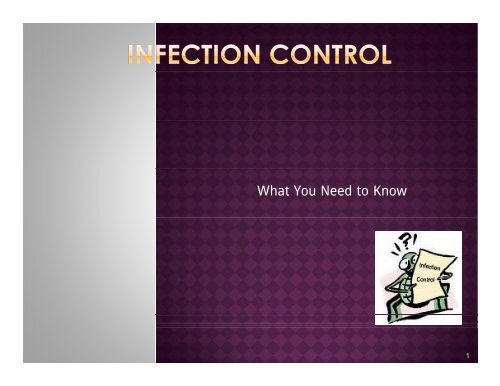
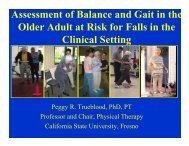
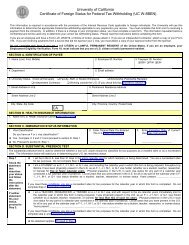
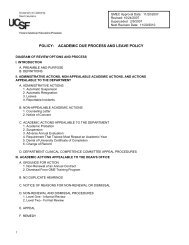
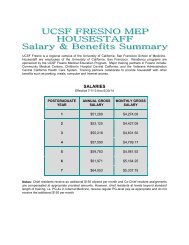
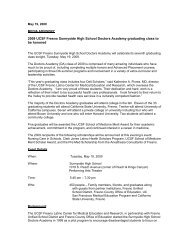
![Assistive Mobility Devices For Prevention Of Falls[1] - UCSF Fresno](https://img.yumpu.com/48127846/1/190x245/assistive-mobility-devices-for-prevention-of-falls1-ucsf-fresno.jpg?quality=85)
